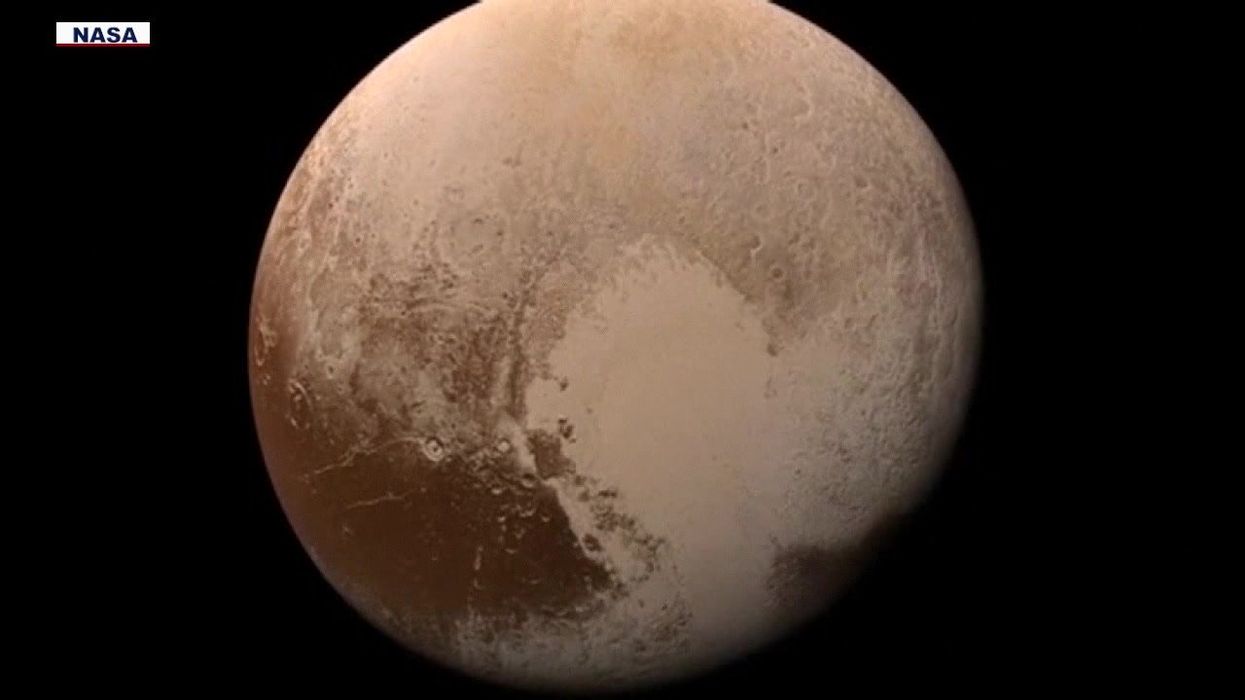Harriet Brewis
Apr 17, 2024
Could Pluto become Arizona's state planet?
Fox - 10 Phoenix / VideoElephant
Poor old Pluto.
Downgraded from a bonafide planet to a dwarf, and now it’s most iconic beauty spot has been given a most undignified explanation.
The complex world, which is studded with mountains, valleys, plains, craters, and even glaciers, has long been celebrated for its heart-shaped birthmark.
The feature, known as the Tombaugh Regio, which takes up a substantial amount of its surface, is an almost perfectly symmetrical, Valentine’s Day-worthy shape.
Yet, when NASA's New Horizons mission discovered the giant mark back in 2015, scientists were left baffled.
Its unique shape, geological composition, and elevation meant they couldn’t figure out what had caused it.
However, an international team of astrophysicists and researchers have finally solved the mystery.
And their conclusion? The 1,000 mile-wide feature was the result of an ancient “splat”.

Experts at the University of Bern, University of Arizona and National Centers of Competence in Research (NCCRs) used computer simulations to investigate the origins of Sputnik Planitia – the western teardrop-shaped part of the heart.
They found that this was formed by a slow but “cataclysmic” collision with a planetary body measuring 700 kilometres (435 miles) in diametre – roughly twice the size of Switzerland from east to west.
The team used their simulation software to digitally recreate such impacts, varying both the composition of Pluto and the planetary body, as well as the latter’s velocity and angle.
This enabled them to deduce that the impact had been slow.
“Pluto’s core is so cold that the rocks remained very hard and did not melt despite the heat of the impact,” Dr Harry Ballantyne, who led the study, said in a press release.
“Thanks to the angle of impact and the low velocity, the core of the impactor did not sink into Pluto’s core, but remained intact as a splat on it.”
Her colleague, Dr Martin Jutzi, further noted: "The elongated shape of Sputnik Planitia strongly suggests that the impact was not a direct head-on collision but rather an oblique one.”
Their co-author Erik Asphaug added: “Somewhere beneath Sputnik is the remnant core of another massive body, that Pluto never quite digested.”
He went on: "We are used to thinking of planetary collisions as incredibly intense events where you can ignore the details except for things like energy, momentum and density.
“But in the distant solar system, velocities are so much slower, and solid ice is strong, so you have to be much more precise in your calculations. That's where the fun starts.”

The heart instantly caught the interest of scientists and members of the public alike upon its discovery, largely thanks to its intensely white colour as well as its shape.
However, the mark is not composed of a single element. Sputnik Planitia covers an area of 1,200 by 2,000 kilometres, which is equivalent to a quarter of Europe or the US.
But what is perhaps most striking is that this region is three to four kilometres lower in elevation than most of Pluto's surface.
"The bright appearance of Sputnik Planitia is due to it being predominantly filled with white nitrogen ice that moves and convects to constantly smooth out the surface,” Dr Ballantyne explained.
“This nitrogen most likely accumulated quickly after the impact due to the lower altitude.”
The eastern part of the heart is also covered by a similar but much thinner layer of nitrogen ice, the origin of which remains unclear but is probably related to Sputnik Planitia.

The team's findings, which have just been published in the journal Nature Astronomy, also suggest that the inner structure of Pluto is different to what was previously assumed – namely, they concluded that there is no subsurface ocean.
Their simulations deduced that Sputnik Plantia’s position near the dwarf planet’s equator was not caused by liquid water under the icy crust, as was once believed, but by the impact of the splat.
"In our simulations, all of Pluto's primordial mantle is excavated by the impact, and as the impactor's core material splats onto Pluto's core, it creates a local mass excess that can explain the migration toward the equator without a subsurface ocean, or at most a very thin one," Jutzi explained.
Dr Adeene Denton from the University of Arizona, a fellow co-author of the study, is currently conducting new research to estimate the speed of this migration.
"This novel and inventive origin for Pluto's heart-shaped feature may lead to a better understanding of Pluto's origin," she said.
Sign up for our free Indy100 weekly newsletter
Have your say in our news democracy. Click the upvote icon at the top of the page to help raise this article through the indy100 rankings
Top 100
The Conversation (0)














